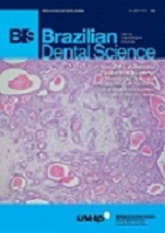Investigation of virulence factors of Enterococcus faecalis strains isolated in secondary/ persistent infections
DOI:
https://doi.org/10.14295/bds.2014.v17i1.961Resumo
Objective: More virulent strains may result from the acquisition of genes by genetic exchange, pathogenicity islands in several species encoding toxins, adhesion factors and other factors associated with virulence. The aim of this study was to investigate the prevalence of E. faecalis strains in secondary endodontic/ persistent using endodontic infection by culture and PCR technqiues; and to investigate for the presence of virulence factor genes of gelatinase (gelE), cytolysin activator (Cyla), surface adhesin of Enterococcus (ESP) and collagen adhesin of Enterococcus (ACE). Material and methods: Microbial samples were obtained from 12 teeth with secondary/ persistent endodontic infection showing apical periodontitis. Culture techniques were used including serial dilution, plating, incubation, and biochemical identification. For PCR detection, samples were analyzed using a species-specific primer of the 16S rDNA and the downstream intergenic spacer region. Results: Culture and PCR detected the test species in 3/12 (25%) and 5/12 (41.6%) of teeth, respectively. A total of 38 Enterococcus faecalis strains were isolated and submitted to the virulence factor genes analysis. PCR products consistent with genes encoding surface adhesion (ESP), gelatinase (gelE) and collagen binding antigen (ACE) were found in 26/38 (68%), 31/38 (81%) and 38/38 (100%) of the isolates. The Cytolysin activator (Cyla) gene was not recovered from E. faecalis isolates. Conclusions: In conclusion, the present study revealed by culture and molecular methods revealed a high prevalence of E. faecalis in teeth with secondary/ persistent endodontic infection. Moreover, of a clinical relevance, we found different E. faecalis strains carrying different virulence determinants.
KEYWORDS Bacteria; E. faecalis; Root canal, virulence.
Downloads
Downloads
Publicado
Como Citar
Edição
Seção
Licença
TRANSFERÊNCIA DE DIREITOS AUTORAIS E DECLARAÇÃO DE RESPONSABILIDADE
Toda a propriedade de direitos autorais do artigo "____________________________________________________________________" é transferido do autor(es) para a CIÊNCIA ODONTOLÓGICA BRASILEIRA, no caso do trabalho ser publicado. O artigo não foi publicado em outro lugar e não foi submetido simultaneamente para publicação em outra revista.
Vimos por meio deste, atestar que trabalho é original e não apresenta dados manipulados, fraude ou plágio. Fizemos contribuição científica significativa para o estudo e estamos cientes dos dados apresentados e de acordo com a versão final do artigo. Assumimos total responsabilidade pelos aspectos éticos do estudo.
Este texto deve ser impresso e assinado por todos os autores. A versão digitalizada deverá ser apresentada como arquivo suplementar durante o processo de submissão.




























